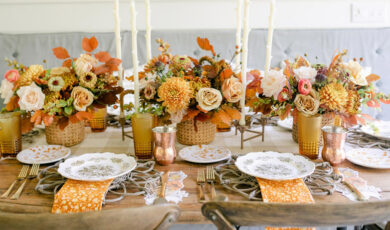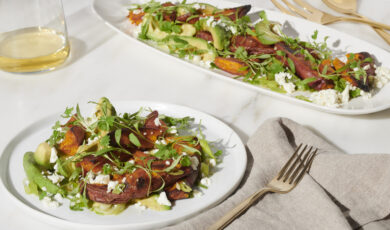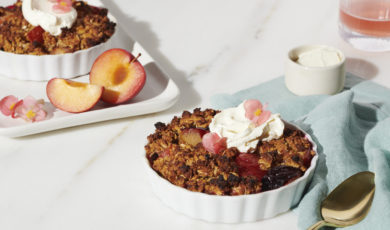Expert Tips for a Memorable—And Sustainable—Friendsgiving
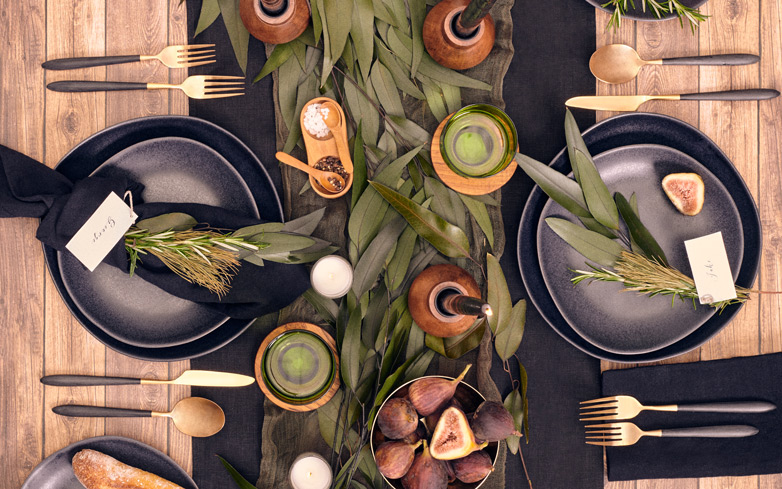
The holiday season might look a bit different this year, but plenty of opportunities still exist to lean into festivities, including the time-honored tradition of Friendsgiving. Traditionally an intimate gathering of just a few friends who opted to stay local instead of traveling home, it’s primed to become a highlight of this year. For help on how to do exactly that, we asked two experts to share their best table setting and menu crafting tips that are also eco friendly, since we’re all about sustainability this holiday season!
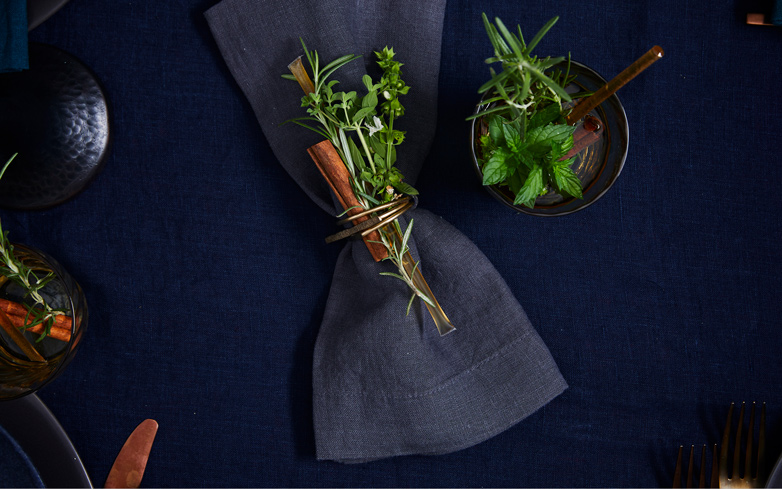
Elevate Your Display with Hand-Picked Fresh or Dried Flowers
Flowers, herbs and other plants still sprout in the cold months, and they can bring a touch of nature to your table.
“Consider taking a trip to your garden or a local greenhouse to collect some blooms for micro arrangements to utilize for your guests’ place settings. This allows you the opportunity to support a small business, and these little bouquets can double as a keepsake for friends to take home with them,” suggests Eddie Zaratsian, owner of Eddie Zaratsian Lifestyle & Design. “Simple yet natural will be key here for crafting your miniature floral pieces — think bundles of lavender or sprigs of dried flowers.”
You can add a sophisticated touch by tying them together with velvet ribbon or twine, and go one step further by personalizing each with a small, handwritten name tag. Fresh or dried flowers can also be used on napkin rings or in a full-blown centerpiece. If you want to take the Friendsgiving theme a step further, lovely autumn leaves, fresh citrus, or mini pumpkins are a beautiful way to add color and dimension to the decor. Plus, weightier items are both festive and wind-proof, if you’ll be dining outdoors.
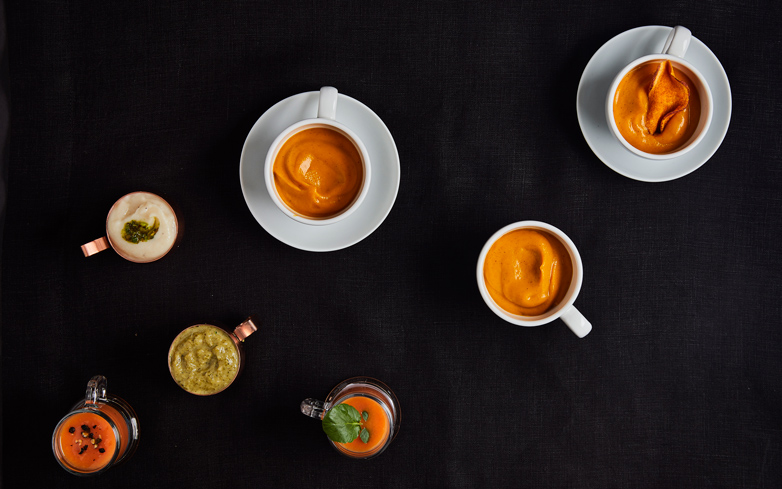
Cook a Delicious, Multi-Tasking Dish
A clever way to reduce both your time in the kitchen and the resources it takes to prep a full meal, is to cook one hero dish, and then use it in a variety of ways throughout your menu.
“For instance, roasted vegetables not only make for a delicious side dish when served as-is but can also be blended into a vegetable puree to accompany other dishes,” says Shifra Klein, editor-in-chief of Fleishigs Magazine. “Additionally, the vegetable puree can also be made into a comforting creamy soup, which can then be used to thicken stews and gravy.”
Using just one vegetable, or two similarly colored and flavored vegetables — like carrots and sweet potatoes — will create the ultimate versatility, adds Shifra. She recommends using organic vegetables, which are better for the environment and also have a sweeter, more enhanced flavor.
Buy Local and Organic Food
On that note, your actual menu is an excellent place to focus on being sustainable and eco-conscious.
“Rather than planning your menu before you shop, walk to your local farmers market or supermarket and choose whichever vegetables look and feel the freshest and most appealing to you,” advises Shifra. “Once you’ve purchased your produce, jot down all of the ways you can envision using these ingredients. Think intro salad, soup and a roasted vegetable platter mixed with grains such as lentils or wheat berries.”
After you’ve finalized your veggies and other side dishes you can then choose a protein to balance out the meal. Ideally, stick with local, organic, grass-fed and otherwise sustainable meat options. It might be a little more expensive, but it’s better for the earth and more flavorful — so you don’t have to eat as much protein to feel satisfied.
Rent Place Settings Versus Buying New (or Using Plastic/Paper)
Unless you’re planning to invest in dinnerware, silverware and the like for the long-haul, renting table spreads and settings is an excellent option. It’s more sustainable that buying and tossing paper and plastic and it takes the hassle out of strategizing your display. For example, Social Studies rents beautifully themed tablescapes that will really wow your guests. Prices range from $22 to $52 per person.
If you do plan to purchase and keep hosting necessities like plates, napkins, and silverware, consider scanning local buy-and-sell groups. You might be able to snag some excellent deals, and it’s a clever way to reduce spending while reusing perfectly beautiful items.
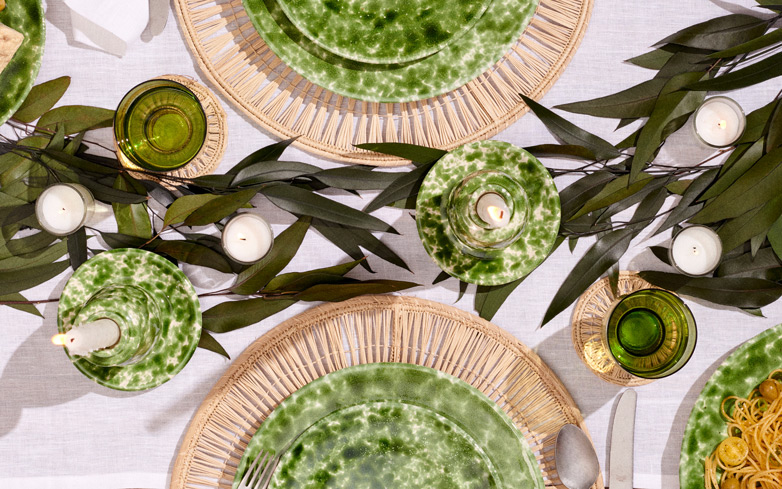
Layer Textures and Upcycle Accent Pieces
The oh-so-common conundrum: you already own enough to create table settings for your guests, but it doesn’t all match. That’s perfectly OK!
“Take a look at your existing home decor or elements from previous events or dinners you may have hosted and see what you can piece together to create a cozy, avant-garde dinner setup. You can achieve some Instagram-worthy, awe-inspiring style by layering various colors, textures and linens,” Eddie says.
For example, instead of writing off your mismatched candlesticks or holders, lean into the trend of using tiered shapes or mixing metallics by clustering them together. Another interesting way to draw the eye is to stack textures, such as jute placemats over a sheer, neutral tablecloth.
Eddie says, “The juxtaposition of harsh and soft is very on-trend, and the same can be achieved with neat, bleached floral arrangements and dark slate or marbled dinnerware.”
Put a Spotlight on Candlelight
The holidays are all about spending time with loved ones, and dim candle lighting is the perfect way to create an intimate atmosphere for a Friendsgiving dinner party. Bonus: you’ll save on energy by minimizing overhead lights.
“Fill your dining area with candles and votives of all shapes and sizes,” Eddie suggests. “Pillar candles add a luxe touch to a fireplace mantle, and tapered candlesticks and tea lights of varying colors serve as the perfect centerpiece for the dining table — even in excess. Candelabras can give the dinner an antique, vintage feel, as well.”
Consider using 100% beeswax candles, which are slow-burning and give off a delicately sweet aroma.
Make Use of Your Food Scraps
Garlic peels and potato skins might seem like they belong in the compost bin (or trash), but don’t write them off just yet. If you’re looking for a way to get creative, Shifra suggests using leftover meat and/or vegetables from the weeks leading up to Thanksgiving to make a stock, which can help add flavor to gravies, purees and stuffing.
“Stock is one of my favorite ways to use up leftover scraps of just about anything, such as onion peels, parsley stems, carrot peels and roots, and chicken or beef bones that you might otherwise throw away,” she says. “It’s super easy to make your own stock, and it serves the dual purpose of minimizing food waste and saving money spent on extra store-bought products (and all that packaging).”
When you cook, set out a bowl where you can throw in all your scraps as you go. Once you’re done cooking, rinse/clean all your scraps and place them in a large pot filled with water. Add one or two teaspoons of salt, to taste, and bring to a boil before letting it simmer for two hours. Finally, strain, cool, and store covered in your fridge or fridge. Shifra says it will last for about a week in the fridge or a few months in the freezer — so you won’t be adding to your to-do list in the days leading up to your fête.


